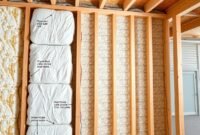If the surface of your insulation is uneven or the insulation board isn’t put together, you will not have peace of mind. This situation gives the possibility of your insulation from falling down to the floor. That said, you will find yourself looking for tutorials on how to keep insulation from falling down.
Check the insulation supports you use to ensure the insulation stays in place. Choosing high-quality wire insulation supports will be beneficial, especially in the attic. These supports must fit snugly and narrowly between the joists to keep the insulation secure.
Read also: How Many Inches of Insulation in Attic
I once had to re-insulate my attic after noticing the fiberglass insulation was sagging. I prevented further issues by switching to high-quality wire supports and ensuring a perfect fit between the joists. Another expert notes that “properly fitting insulation boards without compressing them is crucial for long-term stability.”

| Issue | Solution | Additional Tips |
|---|---|---|
| Uneven insulation surface | Use high-quality wire supports | Ensure snug fit between joists |
| Insulation falling down | Rewind the installation, measure accurately | Consider metal installation hangars |
| Use of fiberglass insulation | Switch to spray foam | Avoid moisture absorption |
Did they fit perfectly between the joists? Or else, were you trying to compress the board to make it glued together?
The Right Size of Insulation is The Key!
When you install the insulation, ensure each board fits the joists seamlessly. Don’t try to flatten or compress it down more than it should be. Consider the R-value as it’s a significant factor in your insulation falling down.
Double-check your measurements when cutting, especially the pointed ends. These are essential for holding the insulation in place between the joists.
Another alternative is using metal installation hangars. These hangars are 12 to 24 inches and can be found at local hardware stores. Each box usually contains 100 hangars.
Using Nylon Straps
Besides wire supports and hangars, nylon straps offer another affordable option for insulation support. Nylon straps are available in large rolls that can be cut to the desired size, suitable for those who prefer customization. This type of support is often used for wider gaps between joists.
You May Use Metal Hangars
Another alternative is using metal installation hangars. These hangars come in many sizes, from 12 inches to 24 inches. They can also be found at your local hardware store easily, and each box is packed into 100 pieces of hangar.
Yeah, you got many backups, didn’t you?
Using Nylon Straps Will Be A Good
Other than those two, you can use nylon straps for another affordable wire insulation support option. Little did you know that nylon straps are available in big rolls that can be cut into the sizes you desire. This is much more suitable for those of you who like the concept of customization.
This type of insulation support is often used for couple-sized gaps in between the joists.
Read also: How to Cut Roll Insulation Accurately
Don’t Use Fiberglass Insulation
While commonly used, fiberglass insulation is not ideal for crawl spaces due to its tendency to absorb moisture, even in non-leaky areas. This absorption can cause the insulation to sag and create an environment conducive to mold growth.
One professional experience emphasized this issue: ‘I replaced my crawl space insulation after noticing dampness and mold growth, switching to spray foam insulation to avoid these problems.
Personal Experience: During a renovation project in my own home, I noticed the crawl space insulation was frequently damp and starting to mold. Replacing it with spray foam insulation significantly improved the situation, preventing further dampness and mold issues.
Final Note
Proper sizing is a priority, no matter what type of insulation you choose and wherever it is located. Insulation shouldn’t be bunched up, compressed, or flattened. Accurate measurements and fitting are crucial to prevent insulation from falling.
Do you have other tips on how to prevent insulation from falling down? We would love to hear them!


